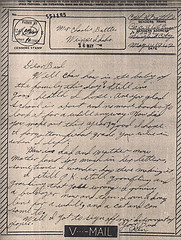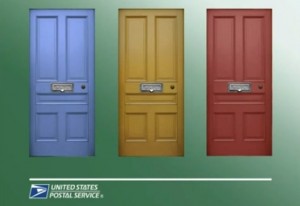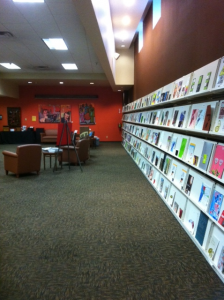Ever since modern postal systems developed in the mid-19th Century, mail has been one of the most common ways of supporting troops stationed far away. A letter from home is one of the few things a soldier in the field can look forward to. Today, e-mail has eclipsed traditional letters in popularity, but this is not the first technological change in the way our troops have kept in touch with home.
![]() photo credit: Homini:)
photo credit: Homini:)
V-mail was developed during WWII as a way to literally lighten the load of mail going back and forth by replacing thousands of letters with reels of microfilm. Correspondence was written on special forms, which were designed to be folded up and sealed to become an integral envelope. These forms were then photographed on microfilm, with several letters fitting on a single reel. This reduced the bulk of the mail 37 times and cut the weight by even more, allowing cargo planes to transport more war materiel.
Once the reels made it to their destination, they would be processed and the individual letters reproduced at about 60 percent of their original size. Then the letters would enter the mailstream for delivery to their addressees.
The process offered security advantages. Secret messages written in invisible ink would not be picked up by the photograph, and thus would not make it to a recipient. And since the original letter would be destroyed after photographing, secret messages could not be sent on microdots attached to the letters either.
![]() photo credit: Homini:)
photo credit: Homini:)
Not everything was perfect with V-mail. Some complained about the forms being too short for meaningful correspondence. Small writing was discouraged, because the letters would not be reproduced at their full size on the other end, and certain colors of ink did not show as well on the photographs as others. But it was a creative solution to some of the logistics problems with delivering mail during wartime, and to the people who used it, it sure was better than no mail at all.
Related Posts:
The Postal Service’s Every Door Direct Mail program offers mailers an attractive new option for getting their message out. Every Door Direct Mail is essentially a streamlined process for sending saturation mail to a targeted area or areas without a mailing list. There are two sides to EDDM, to serve the needs of two different kinds of postal customers.
Retail customers can send up to 5,000 pieces without a permit account. The pieces have to qualify as Standard Flats and weigh no more than 3.3 oz, and they have to be entered and paid for at the post office location that delivers to the area for which the mailing is intended. The mailing needs no addresses, and can be sent to every address in a carrier route, neighborhood or zip code. The sender needs only to add a USPS-specified generic salutation in the address area. Mailers can use a USPS-provided generic permit and pay at the front counter with cash, check or credit card.
The retail option is good for small, local businesses looking to increase their profile, and particularly enticing to those who aren’t used to filling out postal forms and keeping up with the latest rules and regulations. But there’s another side to EDDM, intended to accommodate larger mailings and wider audiences. Sending a campaign this way allows for larger pieces, as well as more of them, but requires the mailer to have an active permit account. Such mailings must be entered at the BMEU much like a regular mailing.
At iPresort, we’re ready to help both kinds of customers realize the advantages of Every Door Direct Mail. Whether it’s inkjet printing the salutation and address line info for a small, local mailing here in the Dallas area, or doing all of the preparation work for a large, national campaign, we know how to make EDDM work for your company.
Related Posts:
More than just affecting how well your campaign makes it through the mailstream, the paper you choose can contribute to the impression it makes on the customer who receives it. Your selection can be used to say something about your company or product.
One of the trends that has developed over the last decade has been an increase in the use of uncoated paper. A heavy, uncoated stock can impart an upscale feel to a piece, and looks contemporary and hip. But it is important to consider the design and images that will be printed on the piece as well. For example, photos of clothing tend to stand out on uncoated stock, but metallic images are often muted by the dull finish.
For pictures of jewelry or cars, a glossy, coated stock is usually a better choice. The shine of the coated stock works well to reproduce these images. Coated stocks have a harder, sharper look to them and are good for images with lots of detail. Certain coatings, however, make it more difficult for high-speed inkjet printers to address, which can slow down production of your mailing.
Indeed, some coatings exist to make paper easier to print on, but the method of printing is important to consider. Modern digital presses don’t always like the same paper as an offset press, or a copy machine. Finding the right paper for your use means looking into every process your mailing will go through, from the printer, to the mailer, through the post office, and finally, to your customers.



